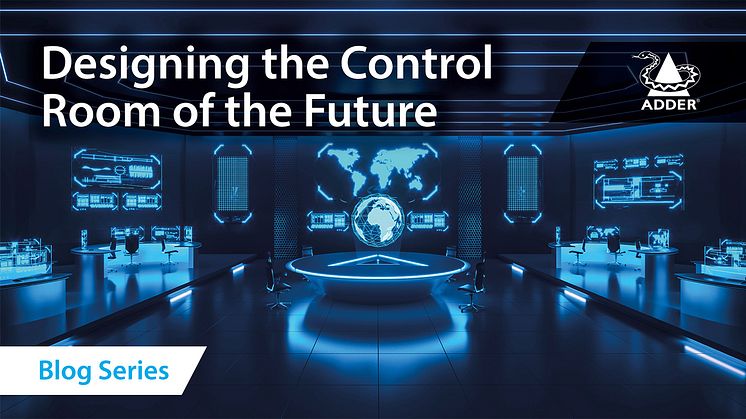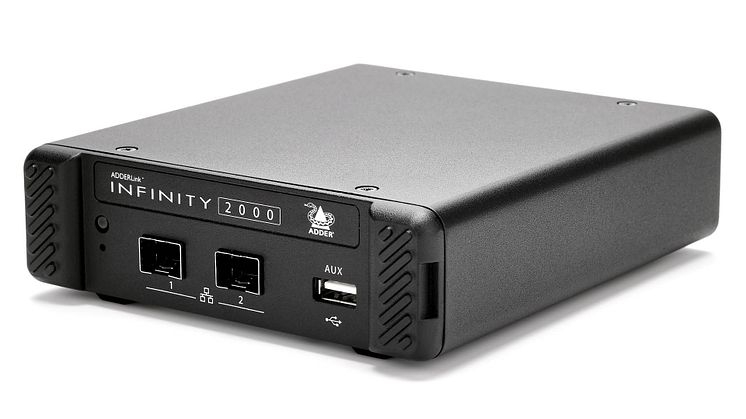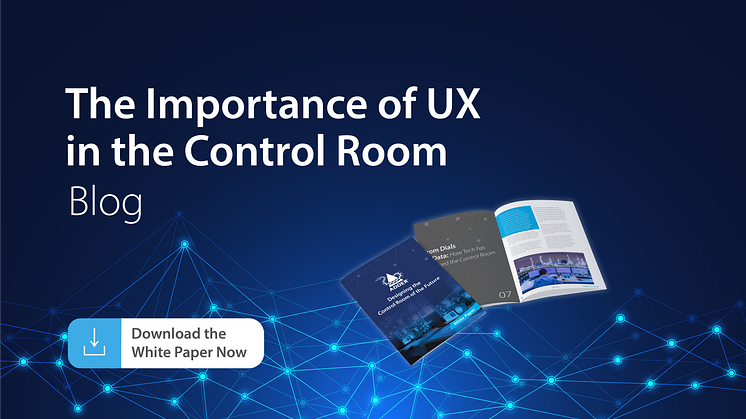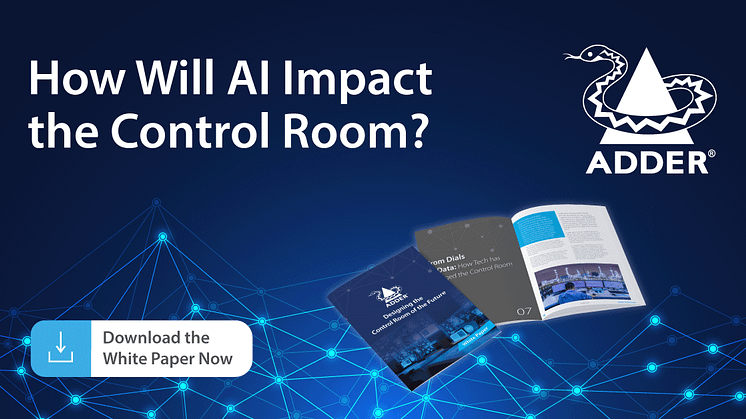
Blog post -
When KVM meets AV Technology in the Control Room
A conversation with Rafael Serrano, Head of Product Management at Adder Technology
We sat down with newly appointed Head of Product Management, Rafael Serrano, to discuss the latest trends and developments in control rooms and how high performance IP KVM and AV are merging technologies that put the operator in more control than ever before. In this Q&A, Rafael shares his expertise in this area sharing insights on the industry today, what has changed and what we can expect in the coming years.
Feedback from our customers indicates that the usage of AV and KVM technology in control rooms is increasing, could you share why this is happening?
“AV and IP KVM are utilized as a key element in the decision-making process to distribute and share vital information across different stakeholders within control rooms. AV technology works in the synchronization of audio and visual content. In other words, AV ensures a seamless relationship between images and sounds which is essential in a control room setting. KVM is the enabling technology that empowers the user to control and access the AV content in real-time, no matter where the data is located.
Depending on the type of control room application, decisions are often based on both audio and visual information sourced from different computers and presented in a variety of formats such as: video content, spreadsheets, SCADA, maps, and network diagrams, to name a few.
“Merging AV and IP KVM is becoming an increasingly preferred method to optimize control room operations as it allows seamless content distribution and source control. Having the AV sources distributed across workstation monitors and the video wall, improves operator’s situational awareness. The operators and supervisors can visually monitor management systems and interact if needed. This technological approach shifts the control room to become a more efficient and secure environment. Facilitating a global view on video walls and a more detailed, focused view on individual workstations, enables operators to make faster decisions in response to the audio-visual information they receive.
“However, designers must be very conscious that operators are the most important aspect in control rooms, aside from the technology itself, and the technology must serve the user, not the other way around. There must be a focus on improving workstation ergonomics and easing mental load, addressing ‘human factors’ when it comes to error, and as a part of driving forward improvements in control room operations.”
In the last 12 months, what significant new developments and innovations have taken place?
“What’s changed? From an IP KVM point of view, the way technology used in control rooms to help operators with their daily processes, makes life easier and achieves a more user focused environment, where technology adapts to the operator. This allows users to switch between AV and computer sources, prioritize, select, and display necessary information anywhere across the control room. Isolating relevant information provides better situational awareness, in turn boosting effective decision-making.
“Following the pandemic, changes were needed to facilitate hybrid working, where operators work at stations located in the control room, or elsewhere, and introducing remote access usage to ensure usability can be facilitated from home.
“Another, often overlooked, improvement of IP KVM and AV seamlessly working together is the ability to maintain high fidelity and responsiveness across workstations, and more importantly, across multiple locations. Recent innovations in IP KVM technology have enabled users to interact with information in 4K at 60fps, with a negligible response time. In applications like broadcast control rooms, this is particularly important in ensuring production runs smoothly.”
Who are the major users of control room technology and is this changing, and if so, how?
“The concept of a ‘control room’ can be applied to such a wide variety of command-and-control scenarios and implementations. With the impact of the pandemic, the adoption of technology hitherto only found in large control room environments is transitioning rapidly into smaller environments. This has been played out in front of our eyes, with the growth of KVM technology being used from secure remote access to critical IT infrastructure. IP KVM offers versatility and adaptability, ensuring that control rooms in every facet of industry can be catered to, examples of this include transportation, emergency control, utilities, manufacturing, broadcast, military and government bodies.”
What are the main requirements that control room owners expect from their AV technology? What key issues and challenges do they face and how do they address them?
“As systems grow, they become more complex and the information transference between users and decision makers may blur. It becomes increasingly important for organizations to keep up and improve their operational backbone. Control rooms heavily rely on interrogating data and information quickly, providing a digestible view for individuals, with capacity for an interactable overview.
“The number of data sources and touchpoints that users need to deal with are increasing, and organizations can only keep up by facilitating robust, dynamic and easily upgradable hardware.
“IP KVM facilitates this, whilst at the same time bridging the gap between the video wall coalescence of data, and the granularity of operator workstations. Allowing operators and managers to have a fundamental awareness of all operational systems, enabling seamless and rapid decision making.”
In your experience, what are the important characteristics of the control room market? What unique challenges does it pose for integrators and manufacturers?
“Control room applications are heavily embedded within mission critical environments. The technology used must be reliable and able to run 24/7. Systems need to be backed up and designed to utilize redundancy pathways in the event of a system failure, ensuring control room operations are not interrupted.
“As systems become more sophisticated, and data points increase, the amount of AV information to process grows too. This generates a control room operation that is far too complex for previous generations of technology to keep up. Current IP KVM solutions are designed with the operator as the central focal point for decision making, and this extends to both manufacturers and system integrators.
“To achieve true optimization in the control room. It is only when all parties are fully aligned that a customers’ pain points are realized.
“By focusing control room designs around the operator, we address two areas. First, we explore operator ‘human factors’, this includes mental load, operational process, possible human errors, and ergonomics. Secondly, we look at situational awareness which includes ‘AV load’ per workplace, content distribution and prioritization of information. By addressing these areas, we can ensure we are addressing potential challenges and setting the control room up for success.”
What do you think will be the future developments in control room technology and the control room market?
“AV in control rooms is growing and consolidated as a key aspect to achieving high performance control room operations, as it facilitates and streamlines key decisions made according to the audio-visual information received.
Future developments in control room technology will present more avenues for the operator to deal with and interrogate key information. Disruptive technologies like AI and VR will generate new process models and solutions associated with it. This is an exciting time for the KVM sector, and we are working on some exceptional opportunities and new ideas to embrace the control room space, now, and into the future.”
DOWNLOAD OUR FREE WHITE PAPER: DESIGNING THE CONTROL ROOM OF THE FUTURE
Are you looking to better manage the ever-increasing quantity of data in your control room?
Download your free 27-page copy of our latest white paper to discover how KVM technology can help prepare your control room to thrive with future change.
This paper is a must-read for anybody working within a control room environment. If you are involved with building a control room, specifying new control room solutions, or working on the upgrade of an existing control room, then this white paper has something to support you.
Discover more blogs in this series:
How is the growth of social media impacting the control room?
5G, Control Rooms and IP KVM: The Perfect Partners
The Importance of Cognitive Ergonomics and Situational Awareness in the Control Room
Planning for the Future of the Control Room: Airport 4.0
The Rise and Rise of Data in the Control Room
The Evolution of the Industrial Control Room
How is the Rail Control Room Changing?
How Has Technology Revolutionized the Control Room?




